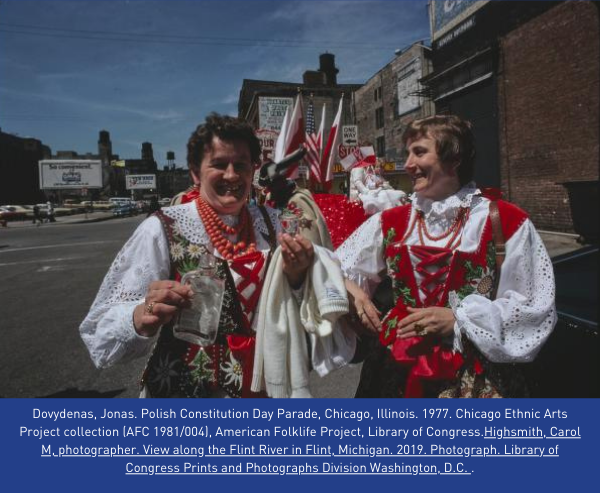
Over the course of the season, we will explore how each of the pieces operates at the intersection of classical and folk musics. In each instance, we will start with a classical construct–that is, a concerto, a symphony, a solo piano piece, and the like–and we will investigate how and to what extent folk idioms are infused into each construct. Together, we will consider each piece as a function of the composer’s unique soundscape comprising all the musics with which he or she was familiar. To do that, I will introduce a number of primary (archival) resources that can be used to contextualize these pieces and nuance our understanding of them beyond what has been the subject of musical biographies and histories. Many of these primary resources are available at the Library of Congress’s American Folklife Center, but I will include others to facilitate our efforts. Some of them can be consulted online, while others may be used onsite at the Library. But all of them, singly and collectively, document the variety of cultural expressions and lived experiences that have been, in some way, referenced by the composers in their works.
On this site, you will find links to manuscripts, unique images, archival repositories and their finding aids, sound recordings, and more. Explore as much as your time permits. Start with the four “quantitative interrogatives”: who? what? when? where?
Use these questions to guide your examination of the resources, individually and in combination with each other. Then, leverage your new (or nuanced) understanding of a particular folk idiom–a dance, a concept, a tune, a rhythm–to expand your knowledge of the piece in which this idiom appears.
Before and after each concert, we will have opportunities to discover new resources, hone our research skills, discuss our findings, and address any lingering questions. With each exchange of ideas comes the opportunity for discovery. May this be the beginning of an exciting musical journey—for all of us!
— Dr. Melanie Zeck
 Frédéric Chopin (1810 – 1849) was born in the Polish village of Żelazowa Wola, which is situated west of Warsaw along the Utrata River. Chopin was raised in a musical family and was largely considered a child prodigy on the piano. The Warsaw aristocracy enjoyed performances by the young musician, who had also begun honing his compositional skills. Having concertized with great success, Chopin decided at the age of twenty to pursue a professional musical career abroad. En route to Paris, he had traveled as far as Vienna when the Warsaw Uprising began at the end of November 1830. Worried and with no updates from home, Chopin remained in Vienna for several months, where he would write some of his most intensive and emotional works. He finally arrived in Paris in 1831, and he stayed there until his death in 1849.
Frédéric Chopin (1810 – 1849) was born in the Polish village of Żelazowa Wola, which is situated west of Warsaw along the Utrata River. Chopin was raised in a musical family and was largely considered a child prodigy on the piano. The Warsaw aristocracy enjoyed performances by the young musician, who had also begun honing his compositional skills. Having concertized with great success, Chopin decided at the age of twenty to pursue a professional musical career abroad. En route to Paris, he had traveled as far as Vienna when the Warsaw Uprising began at the end of November 1830. Worried and with no updates from home, Chopin remained in Vienna for several months, where he would write some of his most intensive and emotional works. He finally arrived in Paris in 1831, and he stayed there until his death in 1849.
Over the course of his career, Chopin wrote almost exclusively for piano, but his compositional output encompassed a range of genres. Among these genres were:
With his nuanced understanding of the instrument, Chopin would ultimately transform genres, such as the instrumental ballade and the nocturne, into ideal vehicles by which to showcase a pianist’s artistic temperament and technical virtuosity. As you listen to Brian Ganz’s performance, consider the idiosyncrasies of Chopin’s style. For example, would Chopin’s writing be suitable for other instruments? Why or why not? Do you think that other composers were influenced by Chopin? How so? And, in what ways was the composer a product of his time, heritage, and circumstances?
*
Chopin’s music is not generally considered “programmatic”—that is, his works do not tend to portray a specific non-musical concept or person. However, he was known to incorporate popular Polish tunes or dance rhythms in his pieces, thereby evoking a strong sense of Polish nationalism within his music.
For example, in the slower and more melodic section of Scherzo No. 1 in B minor, Op. 20, you’ll hear Chopin quote “Lulajże, Jezuniu,” which translates as “Sleep, little Jesus.” Listen to a recording of this Christmas tunemade available by the Library of Congress’s National Jukebox. Note that this recording was made in 1911 by the Chopin Conservatory Male Quartet.
You will also note that references to the five national dances of Poland—mazurka, krakowiak, kujawiak, oberek, and polonaise — can be found in many pieces, even though they were not actually intended to accompany dancing. Which ones will you hear this evening?
—-
To hear examples of Polish dance music, come to the American Folklife Center at the Library of Congress and explore the archival collections. Despite the word “American” in its title, the American Folklife Center has ethnographical materials in over 500 languages (including Polish), documenting cultural expression around the world. The Center also holds collections featuring performances of Polish Americans. Learn how to make the most of your visit to the American Folklife Center. And, when you visit us, be sure to view the wycinanki (Polish paper cuts) on display in the reading room and held in the archive.
National Philharmonic relies on the generosity of its donors to continue bringing you the music. Your contribution is critical to our continued success.